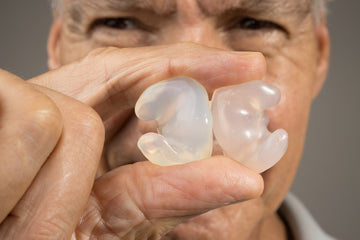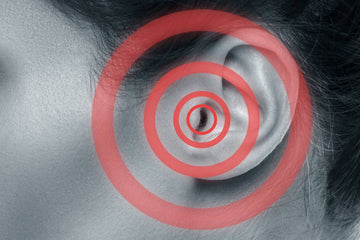Hearing Aid Moulds vs Domes: Which Is The Right One For You?
by Hear Clear on Aug 22, 2024

Let's face it, choosing the right hearing aid is a big decision. And it's about more than just amplification; it's about finding a solution that fits seamlessly into your lifestyle and enhances your everyday experiences. One key factor in this decision is selecting the right interface between the hearing aid and your ear - and that's where hearing aid moulds and domes come in.
If you're unsure about which option is best for you, don't worry; we're here to take you through the differences and help you make an informed choice. After all, your hearing journey is unique, and so is the perfect fit for your needs.
What Are Hearing Aid Moulds?
Hearing aid moulds are custom-made pieces crafted from impressions of your ear canal. They're designed to snugly fit the contours of your ear, creating a secure and comfortable seal. Think of them like a bespoke suit tailored perfectly to your body – except for your ears.
Custom Fit and Personalisation
The beauty of hearing aid moulds lies in their personalisation. By creating a precise mould of your ear, we ensure that the hearing aid sits comfortably and securely, minimising the risk of slippage or discomfort. This personalised fit also plays a key role in optimising sound quality and reducing feedback.
What Are Hearing Aid Domes?
Hearing aid domes, on the other hand, are pre-made silicone or acrylic tips that attach to the end of the hearing aid tubing. They come in various sizes to accommodate different ear canal shapes. Think of them like off-the-rack clothing - a convenient and accessible option, but not necessarily a perfect fit for everyone.
Standard Fit and Convenience
Domes are a popular choice because they're readily available and relatively inexpensive. They're also easy to replace if they become damaged or worn out. However, since they're not custom-made, the fit might not be as precise as a mould, potentially affecting comfort and sound quality.
Key Differences Between Moulds and Domes
Let's explore some of the critical differences between these two options:
Fit and Comfort
Moulds, with their custom fit, generally offer superior comfort and a more secure fit in the ear. Domes can be comfortable too, but finding the right size and fit might require some trial and error.
Sound Quality and Performance
The snug fit of a mould helps to prevent sound leakage, which can lead to feedback (that annoying whistling sound) and reduced sound quality. Domes, while still effective, might not provide the same level of sound isolation and amplification, particularly for those with more severe hearing loss.
Maintenance and Durability
Moulds are generally more durable than domes, but they might require occasional adjustments or replacements as your ear canal changes over time. Domes, being more disposable, are easy to replace but might need to be changed more frequently.
Cost Considerations
Custom moulds typically cost more than domes due to the personalised fitting process. However, the investment can be worthwhile for those seeking optimal comfort and sound quality. If budget is a concern, explore the range of invisible hearing aids uk prices online, as some may offer more affordable options.
Pros of Hearing Aid Moulds
Let's delve deeper into the advantages of hearing aid moulds:
Personalised Fit for Maximum Comfort
The bespoke nature of moulds ensures a snug and comfortable fit, even during physical activity or extended wear.
Better Noise Isolation and Sound Quality
The tight seal created by a mould helps to block out background noise, allowing you to focus on the sounds you want to hear. This results in a clearer and more enjoyable listening experience.
Customisation for Various Hearing Needs

Moulds can be customised with various features, such as vents for improved comfort or acoustic modifications to enhance specific frequencies. This makes them a versatile option suitable for a wide range of hearing loss types and severities.
Cons of Hearing Aid Moulds
It's also essential to consider the potential downsides of moulds:
Higher Cost Compared to Domes
The personalised fitting process and materials used in moulds make them more expensive than standard domes.
Longer Process for Fitting and Adjustments
Creating custom moulds involves taking ear impressions and may require multiple visits to the audiologist for adjustments.
Potential for Requiring Regular Adjustments or Replacements
As your ear canal changes over time, you might need to have your moulds adjusted or replaced to maintain a comfortable and secure fit.
Pros of Hearing Aid Domes
Now let's look at the bright side of hearing aid domes:
Lower Cost and Readily Available
Domes are a more budget-friendly option and are easily accessible through most hearing aid providers.
Easy to Replace and Maintain
If a dome becomes damaged or worn out, it can be quickly and easily replaced without the need for a visit to the audiologist.
Quick and Convenient Fitting
Fitting domes is a relatively simple process that can often be done in a single visit to the audiologist.
Cons of Hearing Aid Domes
Of course, domes have their limitations too:
Less Personalized Fit May Lead to Discomfort
Since domes are not custom-made, they might not fit as snugly as moulds, potentially causing discomfort or slippage, especially during physical activity.
Potential for Less Effective Noise Isolation
The less precise fit of domes might allow some background noise to leak in, affecting sound quality, particularly in noisy environments.
May Not Suit All Types of Hearing Loss
Domes might not be the best option for individuals with severe hearing loss or those who require specific acoustic modifications.
How to Choose Between Moulds and Domes
The choice between moulds and domes depends on various factors, including your hearing needs, lifestyle, and budget. Here are some steps to guide your decision:
Assessing Your Hearing Needs
The type and severity of your hearing loss play a significant role in determining whether moulds or domes are more suitable. If you have severe hearing loss or require specific acoustic modifications, moulds might be the better choice.
Consulting with an Audiologist
An audiologist can assess your hearing, discuss your lifestyle and preferences, and recommend the most appropriate option for you. They can also provide insights on different kinds of hearing aids and their compatibility with moulds or domes.
Testing and Adjustment
Once you've chosen between moulds and domes, your audiologist will ensure a proper fit and fine-tune your hearing aids for optimal performance. Don't hesitate to provide feedback on comfort and sound quality during the adjustment process.
Final Thoughts
Ultimately, choosing between hearing aid moulds and domes is a personal decision, and there's no one-size-fits-all answer, and the best option for you will depend on your unique needs and preferences. Remember, the goal is to find a solution that not only enhances your hearing but also seamlessly integrates into your lifestyle.
We encourage you to consult with an audiologist to explore your options and find the perfect fit. With the right choice, you can rediscover the joy of hearing and embrace a more fulfilling and connected life.




